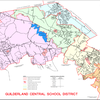FMS continues the Schools to Watch quest
The Enterprise — Melissa Hale-Spencer
Front-row seats: Students from Farnsworth Middle School watch a video extolling the virtues of their school. Later, the students — from left, Sonal Swain, Anish Narain, Aneesh Muppidi, and Benjamin Drzymala — answered questions from the school board. They were joined at the microphone by eighth-grader Elizabeth Dollard, who is seated in the second row, just visible at far right over the shoulder of Drzymala.
GUILDERLAND — More than four decades after it was built, Farnsworth Middle School leaders and staff remain committed to students’ personal and social as well as intellectual development.
The school board on Tuesday watched a lively video highlighting seven “essential elements” that define the National School to Watch Program. Farnsworth was one of 300 schools nationwide to win the designation in 2012; at the end of three years, the application process must be repeated in order for a school to be re-designated.
On Oct. 6, representatives from the State Education Department came to Guilderland for a School to Watch site visit as Farnsworth pursues the designation again.
“These images and pictures only capture some of the story,” Principal Michael Laster told the board.
A house principal, a teacher, and five middle school students then spoke enthusiastically to the board to tell the rest of the story.
Mary Summermatter, who retired from Guilderland last June and is currently serving as an interim principal at Berne-Knox-Westerlo, first pursued the designation when she came to Farnsworth in 2005.
“I wanted to get a clear picture of how our school operates,” she told The Enterprise in 2012. “I found the self-evaluation form the Schools to Watch program puts out, allowing middle schools to examine themselves.”
The program recognizes schools that demonstrate continuous improvement and excel in academic excellence, developmental responsiveness, social equity, and organizational structure.
In New York State, over the past quarter of a century, middle schools, where teaching is centered on the child, have largely replaced junior high schools, where teaching was centered on the subject. Middle schools typically group students heterogeneously rather than tracking by ability, to eliminate competition and foster cooperation. Hands-on activities are stressed that help students solve problems beyond the classroom.
A policy outlined by the state’s education department in 1988 set the tone for the change to middle schools, viewing students between the ages of 10 and 14 as undergoing “profound transformations — physically, psychologically, and intellectually — that are unique in the individual’s life.”
The policy states, “Traditionally, the family, peer group, community, faith institutions, and school served as the supports for young adolescents. However, changes within the home and society have left early adolescents extremely vulnerable, without the support systems which they sorely need…
“The need exists for educators to recognize and assume responsibility not only for their students’ intellectual development but also for their students’ personal and social development.”
The Guilderland School Board last heard from the Farnsworth faculty in force in March of 2012 as it sought to close a $2.6 million budget gap and one of the proposals, to save $210,000, was to cut the daily tutorial period at the middle school.
Tuesday’s session was decidedly more upbeat.
House Principal Michael Pipa, who oversees one of the schools within a school at Farnsworth, spoke of the “breadth, depth, and rigor” of the application process and the “deep reflection” it engendered of the “core mission” of middle-level education.
He then gave “a verbal snapshot” of a half-dozen highlights from the last two weeks at Farnsworth:
— An assembly was held for each grade — sixth, seventh, and eighth — to spotlight the good character of individual students;
— A 15-member team from “an area middle school of considerable standing” visited to learn about best scheduling practices;
— The Future City team came in third in regional competition;
— Three Farnsworth teachers — Alan Fiero, Carol Kelly, and Susan Yagielski — were selected as New York State Master Teachers;
— Students were matched in a Best Buddies program where they formed “powerful friendships”; and
— Chris Vollum, a nationally known expert on social media, is working with students.
Sixth-grade teacher Emily Mineau told the board that, in an era focusing on “numbers, numbers, numbers,” Farnsworth Middle School has remained true to its philosophy of “educating the whole child,” looking at social, emotional, and developmental needs as well as academics.
“They need to be trained in becoming citizens of the world,” she said.
She praised the “luxury” of having a period in the day where teachers could collaborate with each other and talk about how students are handling challenges.
She also praised monthly inquiry sessions where faculty members offer mini courses on everything from the arts to Google Chrome. “We teach one another,” said Mineau.
Students have their say
Five students then stood before the board, giving candid answers to their questions.
Judy Slack asked what their favorite part of middle school was.
“It’s so much more independent,” said sixth-grader Aneesh Muppidi. “We make our own choices.”
Sixth-grader Anish Narain said he liked the way two teachers shared adjoining rooms so that the students could collaborate with each other.
“Coming to the middle school, I got to meet an enormous amount of people, I made so many friends,” said eighth-grader Sonal Swain.
Eighth-grader Benjamin Drzymala made some board members smile when he replied what he liked was the “bigger selection at lunch with more snacks.”
Finally, eighth-grader Elizabeth Dollard said she valued the access period “where you choose what you want to do…Best Buds showed me what I want to do when I grow up.”
The answers were just as wide ranging when board member Gloria Towle-Hilt, a retired Farnsworth social studies teacher, asked the students about their favorite subjects.
Swain favors biology. “I like learning how the world works and what makes us who we are,” she said.
“I’m not that deep,” said Narain. “I want to be an astronaut. I love math and science.”
Mupidi, too, favored science. “We learn something new every time,” he said. “It makes me excited.”
Drzymala likes gym class, he said, and also social studies where, he said, “You get to learn what our country went through and how lucky we are.”
Dollard likes math because her teacher caters to each child.
Board member Christine Hayes asked what it was like to be on a team.
“You get to see the perspective of others,” said Swain. “You learn how to cooperate.”
“I think we have a lot of unity,” said Narian. “Our team is very creative,” he went on, giving an example: “We’ve been studying about ancient Egypt. We named our groups Luxor and Thebes.”
“Last year, we had one teacher, which is great,” said Mupidi, “Having two teachers is even better.”
“You don’t feel alone,” said Drzymala.
“You see different learning styles,” said Dollard.
The school board president, Barbara Fraterrigo, wanted to know about the students’ experiences with technology.
“Each student has their own gmail,” said Narain. “We can collaborate.” He said that students can post things, adding, “They have to be appropriate.”
Also, he said, homework is posted, “so you really don’t have any excuse of not having your homework.”
Muppidi said that communication was easier through Google, noting a student can’t ring his teacher’s doorbell at night to ask a question but, he said, “You can just shoot her an email.”
Drzymala said a TV news club helps with career choices. “It helped me see what I want to do,” he said.
Final board queries centered on what clubs or special classes the students liked.
Muppidi termed the Future City competition “amazing” and said, “It helps you learn how engineers work. You collaborate ideas to come up with solutions for problems. It’s really fun.”
Swain said she liked art class and playing in the orchestra. “It lets me visualize how I feel in another way besides words,” she said.
Drzymala enjoys trips to Jiminy Peak every Thursday with the ski club and he likes being part of the theater program as does Dollard. Dollard also like Best Buddies. “I’ve learned to help people,” she said.
Several students cited their foreign language classes, both French and Spanish, as favorites.
Muppidi likes his Family and Consumer Science class. “It connects you with your home,” he said. “You can cook, you can sew.”
Swain likes health class “to see what’s going on in the world around us.”
Narain likes gym class for its variety of activities; he called adventure climbing with a harness “really cool.”
“You guys are very cool,” responded a school board member.


